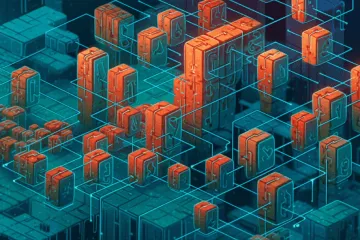As you have no doubt heard, blockchain is a big deal. It’s the basis of most cryptocurrencies today and is responsible for maintaining almost 1 trillion US dollars worth of crypto as I write this.
Blockchain technology has several uses beyond its role in cryptocurrency. It can be used to keep track of supply chains, prove ownership of physical assets, allow patients and doctors to selectively share and confirm medical data, pay royalties to musicians, buy and sell real estate, and much more.
But how? What is so special about blockchain? And how can it be used to do all these things?
In this series of articles, we will dive deep into what blockchain is and some of its most common applications. We will explore why blockchain is a big deal and examine its limitations.
What is Blockchain?
One way to think about blockchain is as a giant ledger or spreadsheet that can track any information you want. In the case of cryptocurrencies, the tracked data is either account balances (in the case of Ethereum-like chains) or the owner of specific coins (in the case of Bitcoin-like chains).
But the information you put in the spreadsheet is limited only by your imagination.
Blockchain provides this giant spreadsheet with essential characteristics; and these characteristics are the true source of blockchain’s value as a platform for enhancing so many applications. These can be summarized into three key areas:
- Security,
- Decentralization, and
- Openness.
Let’s explore each of these characteristics to understand better the multifaceted value provided by blockchain.

Security
This is the big one. The benefits of blockchain would have no merit if it was not secure. This security permeates all other elements of the blockchain and is achieved through a series of mechanisms.
Blockchain’s security reveals itself in many ways:
- Cryptographic access: Every blockchain user has a unique username and password, better known in blockchain terminology as an “address” and “private key.” The address is 40 characters long, and the private key is 64 characters long. These are not random but have special mathematical properties that connect them. Only the private key owner can change the data belonging to the address, like withdrawing or transferring money to someone else. Such changes are called transactions.
- Verifiability: Anyone in the world can verify whether transactions are valid. The address and private keys mathematical properties allow the verification to be performed even without knowing the private key.
- Immutable history: Once a transaction is completed, it cannot be changed. Errors can only be corrected by adding new transactions. If you send money to the wrong person, you will only get it back if that person agrees to add a new transaction that returns the money.
- Zero-trust: Blockchain runs on a giant network of computers. A key goal of the operation of this network is that no one on the network needs to trust anyone else. All the computers (also called nodes) on the network interact using a specially designed language called a “protocol,” which is used to share information about new and past transactions. Every computer interacts with multiple other nodes simultaneously, verifying all the transactions it receives for itself. The current state of the blockchain emerges as a consensus between all these computers.
Decentralization
Decentralization goes hand in hand with security. Decentralization means that no one computer or person is in charge of the operation of the blockchain. This concept can be seen in the following ways:
- No one computer or even one cooperating group of computers can insert illegal transactions into the blockchain (to steal someone else’s assets, for example). To do so would require them to take control of over half the computers – not an easy task when you consider that there can be as many as 8,000 Ethereum nodes and 50,000 Bitcoin nodes at any one time.
- Blockchain operates on a “peer-to-peer” basis, meaning no computer or node in the blockchain has more authority than any other. All computers on the blockchain network have well-defined roles to work together symbiotically.
- The computers are said to be “distributed,” which means that the data and processing of the blockchain is spread over a large number of computers over wide geographical areas. As a result, even if some disaster or authoritarian government policies disrupt regional internet service or node operation, most will be unaffected, and the blockchain will continue to operate.
- Blockchain is deemed ”borderless,” referring to the fact that the distribution of nodes goes beyond political borders. This is an important element of decentralization because it means that even a determined nation-state would find it difficult to control the blockchain.
Openness
The quality of “openness” is both a consequence and a requirement of blockchain’s ability to continue in operation. It manifests itself in the following ways:
- Open source code: The software most nodes use is open source software. This means anyone can verify, test, analyze, and study it. Anyone can suggest improvements and new features, identify bugs, comment, criticize, innovate and generally get involved in the development and maintenance of blockchain.
- Open access: Anyone can connect a new node to the blockchain network and start verifying transactions. There is no authentication, credentials, or permissions needed.
- Open source protocol: The mechanisms by which nodes on the blockchain network communicate with each other are well-known and standardized. So, even if you write a new version of the software and put it on a node, you still need to follow the rules of the protocol. The protocol defines how new nodes can learn about the history of transactions and add new ones.
- Transparent processes: There is visibility and transparency with all updates, improvements, and distribution processes within blockchain. This includes the protocols used by nodes to communicate with each other.
- Transparent data: The data and transactions for most applications on blockchain are visible and open for verification by all users, demanding full accountability for all parties making transactions.
Conclusion
Blockchain technology offers a unique combination of security, decentralization, and openness, making it a game-changer in the world of cryptocurrencies. However, these characteristics make it an ideal platform for various applications beyond digital currencies. From supply chain management to acquiring real estate, blockchain’s decentralized and secure nature provides a powerful tool for creating transparent, trustworthy, and efficient systems. As blockchain technology continues to evolve, we can expect to see even more innovative applications emerge, transforming industries and improving our daily lives in countless ways.
In the next article, we will look at some of the most important applications of blockchain technology today. If you’re interested in developing a blockchain project, contact us to discuss it.
Photo by NASA.



